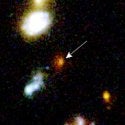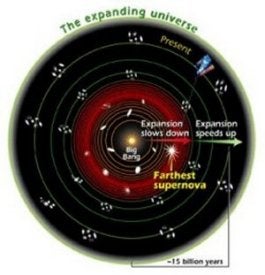Skeptics wondered if perhaps another explanation could account for the observations. Perhaps as astronomers look farther and farther through space, more and more dust is in the way, dampening the light from faraway supernovae. If this is the case, supernovae would continue to appear fainter and fainter than expected all the way back to the beginning of time.
However, in 2001, Adam Riess of the Space Science Institute and other astronomers reported that the most remote type Ia supernova ever observed, Supernova 1997ff, actually appears brighter than expected. This observation by the Hubble Space Telescope confirmed the idea that in the very early universe gravity initially slowed down the cosmic expansion following the Big Bang but eventually gave way to the “dark energy” which is now hastening the universe’s expansion.
This illustration represents how the universe’s expansion was at first slowed down by gravity and then began to accelerate. The concentric red circles show galaxies separating more slowly during the first half of the universe’s history. Then a mysterious force astronomers call “dark energy” overcame gravity and began pushing galaxies apart at an faster rate. This later stage is marked by green circles. Astronomers found evidence for this model when they observed Supernova 1997ff, the farthest supernova ever seen, which demonstrated that the early universe was decelerating.











